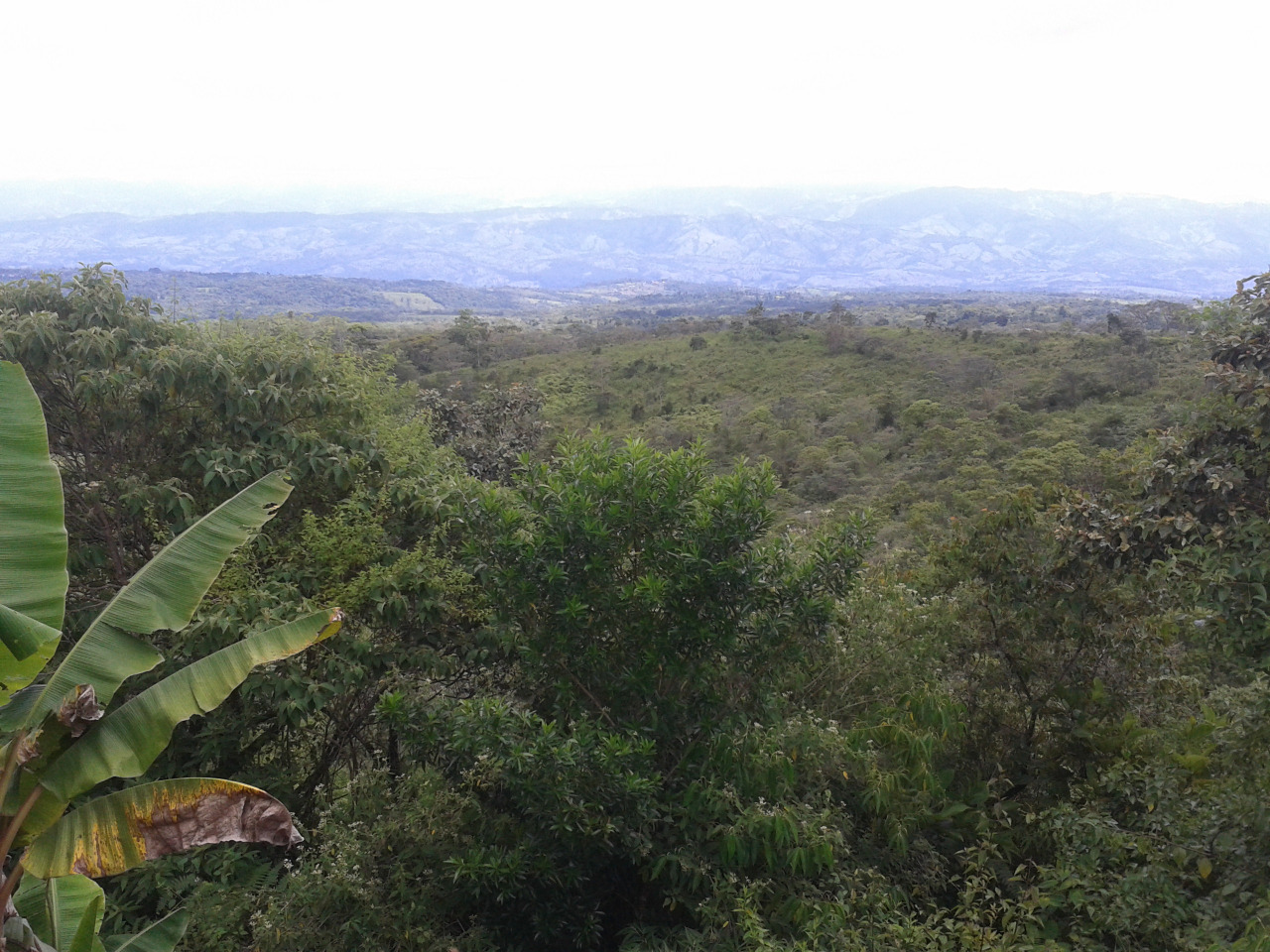Erste Arbeitswoche / First week at work
10.09.2014 00:07Nachdem der Montag ja schon im letzten Bericht mit drin ist, fang ich jetzt gleich beim Dienstag an.
Since Monday is already included in my last blog entry I will go on with Tuesday now.
Ich dachte ja der Arbeitstag in der Tostadora am Montag war anstrengend, aber am Dienstag sollte mir gezeigt werden, dass ich mich da wohl getäuscht hatte. Habe ich am Montag noch mit Frauen zusammengearbeitet, so war ich am Dienstag (und auch den Rest der Woche) die einzige Frau in dem Bereich, in dem ich aushelfen sollte. Auf meinem Weg zur Arbeit habe ich schon die zweite Tarantel gesichtet. Zwei Tage, zwei Taranteln – die Quote ist nicht schlecht würde ich sagen. Dienstag ging es für mich zur Konstruktion, also auf die Baustelle der Herberge, die im Dezember fertig werden soll. Mein Vorgesetzter in diesem Bereich und Kollege, Hector, ist sehr nett und hat mir alle Sachen genau erklärt, immer wieder eine kurze Pause zum Ratschen eingelegt und mir während der Mittagspause neue Wörter beigebracht. Auf der Baustelle habe ich die vordere Außenwand der Herberge, die mit rustikalen Brettern verkleidet ist, komplett abgeschleift (mit einem kleinen Stück Schleifpapier), bis die wirklich richtig glatt war und dann begonnen die ersten Bretter mit Holzlack zu bepinseln. Kurz vor Feierabend kam dann Doña Laura und hat mich gefragt, ob ich gerne sehen möchte wie die „Kaffeemaschine“ funktioniert. Klaro hab‘ ich da nicht nein gesagt. Als erstes haben wir auf einen Zulieferer gewartet. Dann wurde mithilfe von verschiedengroßen grünen Metallkisten das Volumen des Kaffees gemessen und die Kaffeefrüchte wurden in einem großen Becken gesammelt. Als die ganzen Kaffeefrüchte in dem Becken gesammelt waren, begann der Entkernungsprozess. Wir haben Wasser in das Becken gepumpt und mit dem Wasser zusammen sind die Kaffeefrüchte langsam durch eine Öffnung durch eine Waschstraße geflossen um von einer Spirale nach oben zum „Schredder“ befördert zu werden. Dort angekommen sind die Kaffeefrüchte durch einen Trichter gefallen, der einen Ring wie ein Hobelbrett in sich trägt, der sich ganz schnell dreht. Dort ist dann die Schale abgemacht worden und der Pergamino (Kaffeebohnen ohne Schale) ist in eine Kaffeewaschanlage gekommen, in der viele Bürsten den Kaffee gebürstet haben bevor er durch ein Rohr in ein anderes Wasserbecken geleitet wurde. Die Schale wurde an der Seite aus der Maschine gepumpt. (Das sind jetzt offensichtlich nicht die Fachbegriffe, aber ich denke so kann man sich das ganze doch recht gut vorstellen). Nach der ganzen Prozedur haben wir dann zu dritt die Maschine auseinander genommen und geputzt – eine Heidenarbeit! Um halb 6 hat mich Doña Laura dann nach Hause geschickt, damit ich noch vor der Dunkelheit im Haus bin. Um 7 ging‘s dann ab ins Bett für mich. Vor lauter Muskelkater konnt‘ ich eh nix anderes machen als zu Schlafen.
I thought that the work in the Tostadora on Monday was hard, but Tuesday did well on showing me that I was mistaken. If I was working with only women on Monday, I found myself as the only woman with only male colleges on Tuesday (and also the rest of the week). Walking to work in the morning I saw the second tarantula during my stay here. Two workdays, two tarantulas – I guess the rate is pretty good. Tuesday my work schedule sent me to the construction work, helping out with the hostel that is supposed to be finished by December. My boss in the construction area and college, Hector, is very nice, explained everything very detailled to me, made little breaks for talking a bit and taught me new vocabulary during the lunch break. I sanded the outside front wall of the hostel which is covered with all wood and painted it with wood paint. Shortly before the end of the work day Doña Laura asked me if I wanted to see how the „coffee machine“works. Of course, I didn’t want to miss out on that. At first we were waiting for the person to bring us the coffee fruit. Then we measured the volume of the coffee fruit and gathered all of the coffee in a big bowl. Then we pumped water into the bowl and the water together with the coffee passed through a small opening and was cleaned from all the dirt before being taken up to a machine that separated the coffee from the peal. After that the coffee was cleaned again and pumped into another bowl. The peal was pumped out of the machine at the other side. (Obviously this is no specific vocabulary, but I think it works for imagining how it works). After that we cleaned the machine which is a full load of work. At 5.30pm Doña Laura sent me home so I would be in the house before it became dark. At 7pm I went to bed and with all the sore muscles there couldn’t have been anything I had rather done.



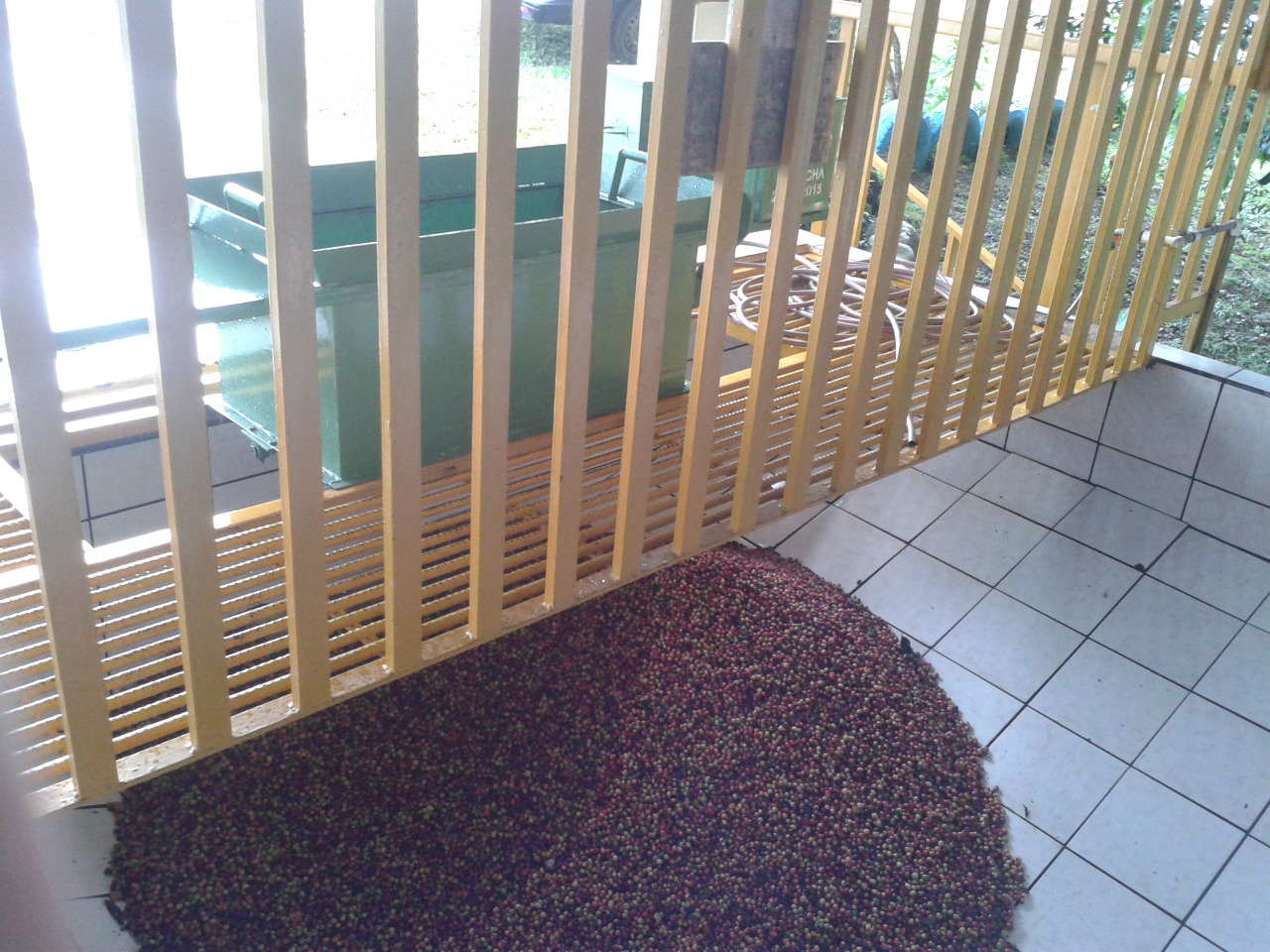
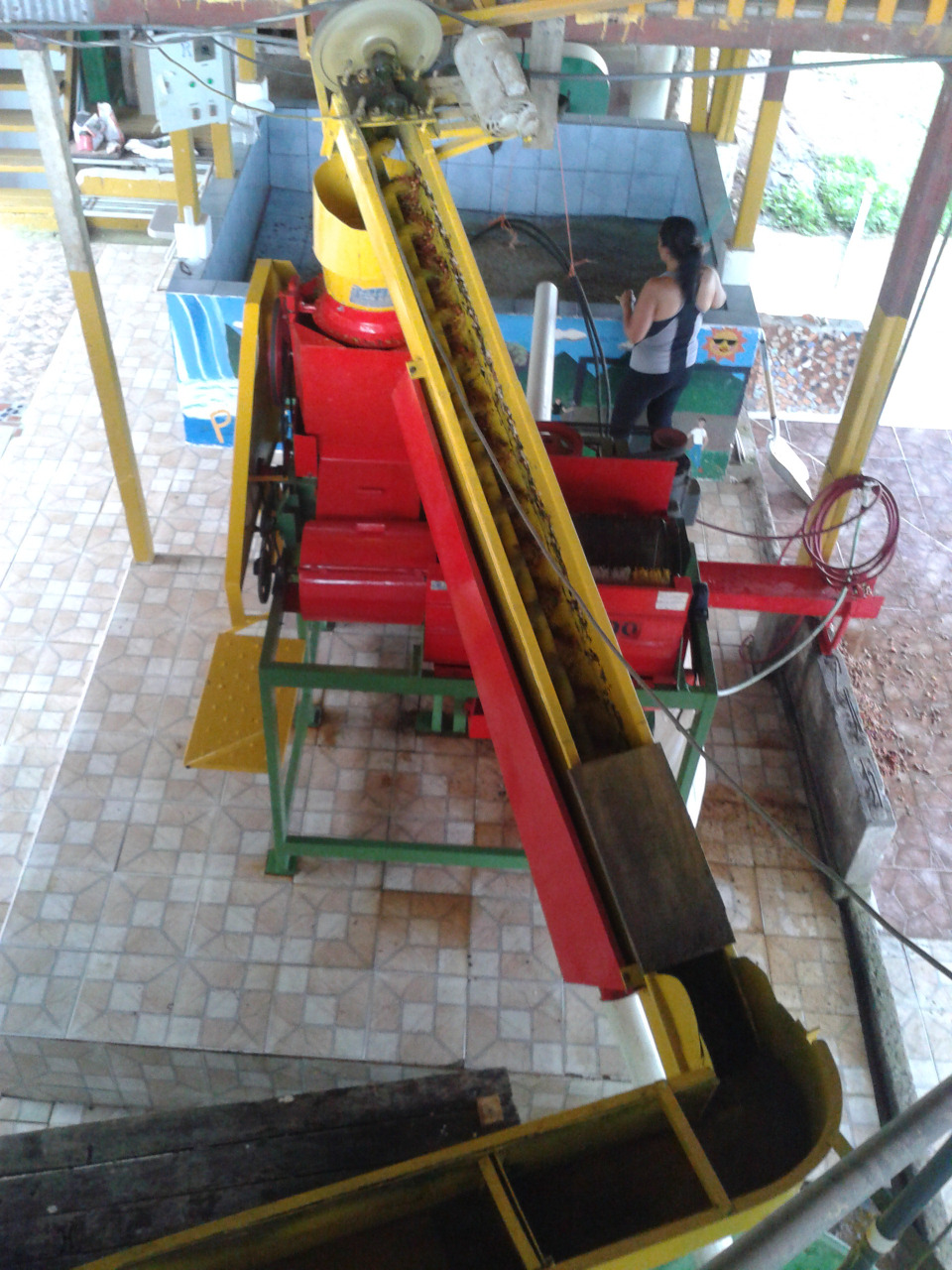


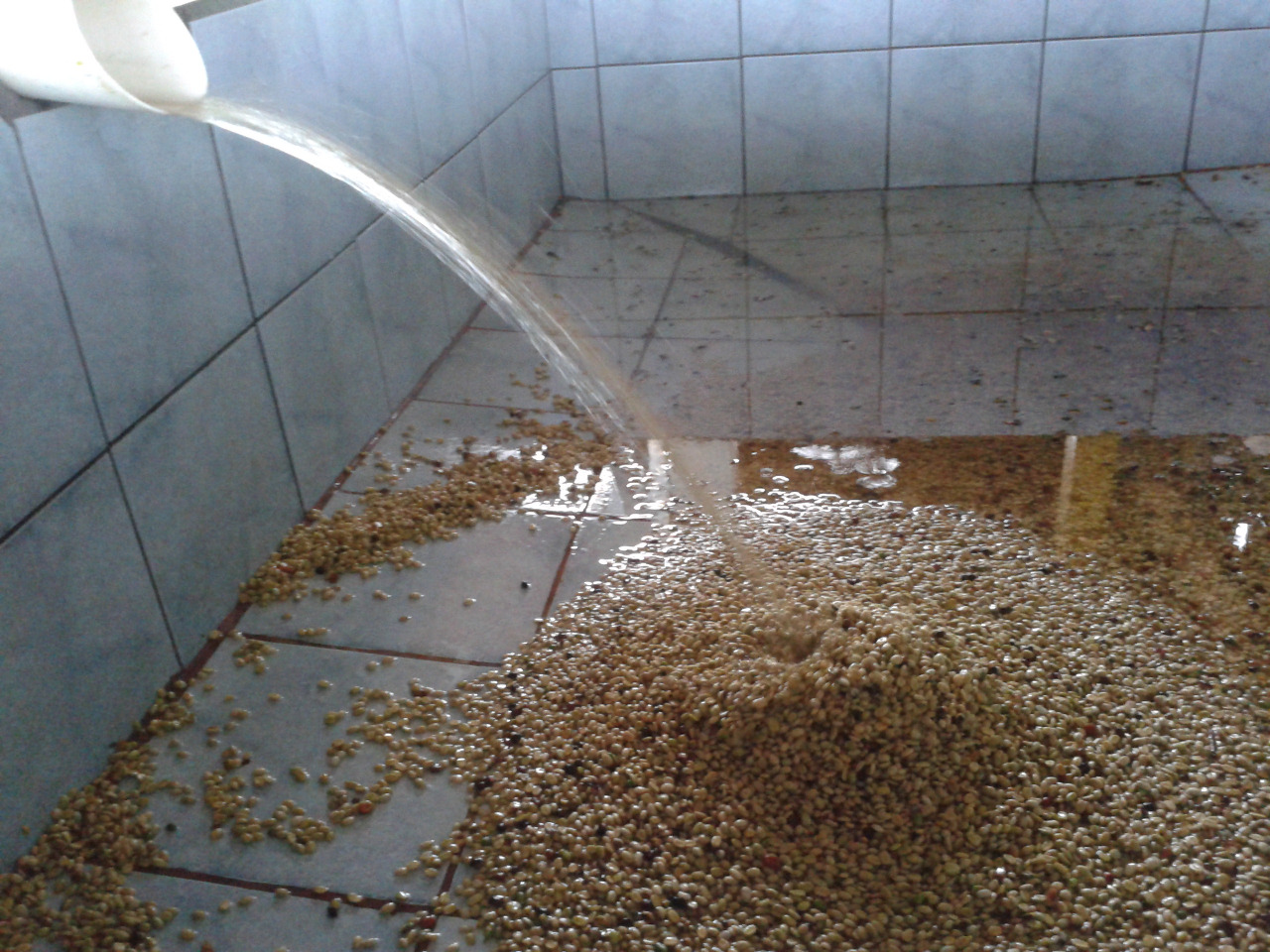

Am Mittwoch hieß es wieder Baustelle für mich. Der Weg zur Arbeit war auch heute nicht kürzer und ich habe mich auf das Härteste eingestellt: nochmal den ganzen Tag lang schleifen. Sehr positiv war dann, dass ich heute als erstes Streichen durfte – wesentlich angenehmer. In der Mittagspause hat Hector dann ganz verschiedene einheimische Früchte für mich zum Probieren mitgebracht. Pejibaje, Nancys und Jocoten. Supernett von ihm. Die Früchte haben alle sehr anders geschmeckt, als Früchte, die man in Deutschland kennt, aber lecker. Nach Gesprächen über Autobahnen und Tanken hinter der Grenze (wir wohnen sehr nah an Panama), hab ich dann die drei Männer aus dem Bereich Beneficio kennengelernt. Danach war die Pause auch vorbei und es ging weiter mit Türen abschleifen und mit Holzlack bestreifen. Manchmal durfte ich auch kurz beim Fließen legen oder Betten von einem Zimmer ins andere tragen helfen. Heute war dann ganz normal um 4 Uhr Schluss und nach einem „saubere Arbeit“ bin ich erschöpft, aber glücklich nach Hause gegangen. Abends kamen dann Giselle (meine Tante und Mentorin) und eine andere Arbeitskollegin zum Abendessen vorbei. Es kamen die lustigsten Gesprächsthemen auf und wir haben alle zusammen ganz viele verschiedene Wörter für Schmeichler auf Spanisch, Englisch und Deutsch gesammelt. Aufhänger der Diskussion war das Wort Brocha (wörtl. Pinsel), das es in San José gibt, hier in Biolley aber keiner in diesem Zusammenhang gekannt hat.
On Wednesday I went back to construction work. The walk to work wasn’t shorter than on any other day and I was prepared for the hardest: One more day full of sanding. I felt great when I was told that I was going to paint instead of sanding! Much more fun! During lunch time Hector brought me a lot of different local food to try: Pejibaje, Nancys and Jocoten. Really nice of him! The fruits tasted different that the fruits I already knew, but delicious. After talks about the highway and using the gas station on the other side of the border (we’re living close to Panama) I was introduced to the three men who work in the area of Beneficio. After that the lunch break was over and I went on with now sanding doors and painting them. Sometimes I was also able to help out with the tiles or with carrying beds from one room into another. The day at work ended today at 4pm and after a “good job” I went home tired, but happy. For dinner Giselle (my aunt and area rep) and another college from work came to our house. We had a lot of fun talks and searched for different words to describe a flatterer in Spanish, English and German. The discussion started because some people in San José use Brocha (=brush) to describe such a person, but in Biolley nobody really uses this word.

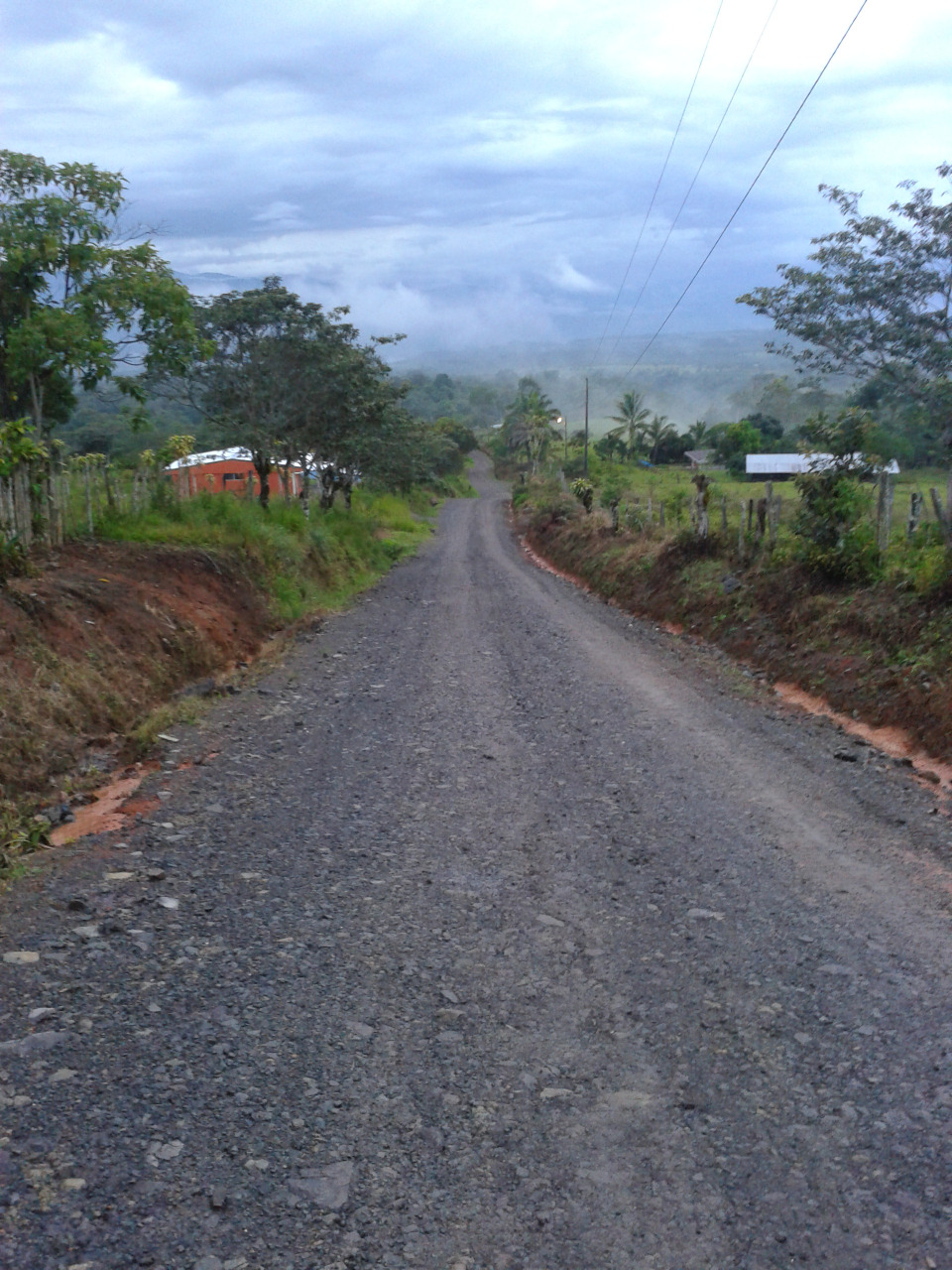
Donnerstag hieß es dann für mich arbeiten im Bereich Beneficio. Mein Vorgesetzter in diesem Bereich heißt Geovany und ist so, wie man sich einen Kaffeearbeiter im Regenwald so vorstellt: Beiger Hut, grüne und braune Kleidung, braun gebrannt vom Arbeiten in der Sonne, Gummistiefel und immer eine riesen Machete am Gürtel. Wir haben Kaffee umgewälzt, die Schale an der „Kaffeemaschine“ auf den Kompost gebracht und mit Calcio bestreut, damit kein unangenehmer Geruch entsteht, Löcher in den „Kaffeebetten“ geflickt, geputzt… Einige Kaffeebetten sind in einer Art Gewächshaus, damit der Kaffee besser trocknen kann und vom täglichen Regen geschützt ist. In diesen Gewächshäusern auf Metallstreben und Plastikfolien ist es so heiß, dass nach ca. einer Viertelstunde Schmetterlinge und Bienen an der Hitze sterben. Wir haben also, wenn mal kurz weniger zu tun war, die Schmetterlinge und Honigbienen mit unseren Hüten gerettet ;) In kurzen Pausen hat er mir auch verschiedene Gewürze und Früchte gezeigt, die auf dem Gelände von ASOMOBI wachsen und wie man Bananen erntet. Zuerst war ich total geschockt, als er plötzlich ohne Vorwarnung seine Machete zückt und einfach den Bananenbaum mit einem Hieb abschneidet, aber dann hat er mir erklärt, dass ein Bananenbaum nur einmal Früchte hat und man ihn umschneiden muss, damit er neu austreiben kann. Die Bananen ganz frisch vom Baum waren echt superlecker. Die Arbeit in Beneficio ist sehr anstrengend, aber auch sehr interessant. Nachdem ich schon schlimme Geschichten über diesen Bereich gehört habe, hab‘ ich mich auf das Schlimmste gefasst gemacht, aber so schlimm war es dann doch nicht. Auf die Sommertage (Dez-April) in den Gewächshäusern freu ich mich aber trotzdem noch nicht. Um 3 Uhr war dann wieder ein weiterer Arbeitstag zu Ende nachdem mir Geovany noch einige Wörter beigebracht hat und ich durfte mit ihm, Angela und deren Tochter im Auto zurück ins Dorf fahren. Zuhause angekommen wurde ich dann überrascht als ich in mein Zimmer ging. Meine komplette Wäsche lag gewaschen, getrocknet und sauber zusammengelegt auf meinem Bett. Was für ein Service nach einem anstrengenden Arbeitstag.
Thursday I worked in the area of Beneficio. My boss in this area is called Geovany and he is really like somebody might imagine somebody who is working with coffee in a rain forest: Beige hat, green and brown clothes, tan from working in the sun, boots and always carrying a big machete at his belt. We moved coffee, composted the peal of the coffee fruit that was left from using the “coffee machine” and put “calcio” on top of it to prevent bad smell, repaired holes in the “coffee beds” and cleaned,… Some of the coffee beds are in a greenhouse, so that the coffee can dry better and is sheltered from the daily rain. In those greenhouses made out of metal and plastic foil it is so hot that after about 15 minutes butterflies and bees dye. When we had a little bit less work, we tried to catch and safe the butterflies and bees with our hats. During small breaks he showed me different spices and fruits that grow on the property of ASOMOBI and how to harvest bananas. At first I was really shocked when he just used his machete and cut down the banana tree, but then he explained to me that a banana tree can only grow fruits once and that by cutting it down he gives it the chance to grow again and have new fruits. Bananas fresh from the tree were just delicious. The work in Beneficio is exhausting, but very interesting. After hearing several bad stories about this area, I was prepared for the worst, but it wasn’t all that bad. However, I am still not excited for spending the summer days (Dec-April) in the hot greenhouses. At 3pm another work day ended and after being taught some new vocabulary by Geovany I could drive back to the village with him, his wife and daughter. Back at home I was happily surprised when I walked into my room: All of my laundry lay washed, dried and folded on my bed. What a nice treat after a day at work!



Freitag ging’s wieder weiter im Bereich Beneficio. Ich glaube langsam gewöhnt sich mein Körper an die Arbeit. Heute habe ich selbstständig den Kaffee gewälzt und die Löcher geflickt. Wenn man frischen Kaffee wälzt, dann ist der noch ganz nass und klebrig vom Kaffeehonig. Wenn man diesen frischen Kaffee wälzt, dann wird man oft von Ameisen gestochen, die den Honig lieben. Ich hab‘ gelernt, dass es zwei verschiedene Arten gibt Kaffee zu trocknen: mit Schale und ohne Schale. Der Kaffee ohne Schale heißt Pergamino und ist herber, der Kaffee mit Schale heißt Beyota und ist eher süßlicher, da er mit dem Honig zusammen getrocknet wird. Da es heute nicht so viel Arbeit gab, hab ich um 2 Uhr die Arbeit in Beneficio abgeschlossen und noch ein bisschen auf der Baustelle geholfen. Die Mittagspause hab‘ ich dann gemütlich in einer Hängematte verbracht mit dem schönsten Ausblick des Ortes vor mir. Nach der Arbeit bin ich erstmal duschen gegangen und als ich mich abtrocknen wollte, war ich richtig geschockt! Nachdem meine Arme und Beine schon trocken waren sehe ich ein Tier in meinem Handtuch! „Tropenerprobt“ (hahaha) hab‘ ich ein anderes Handtuch benutzt, mich angezogen, mein Handy aus meinem Zimmer geholt, ein Foto gemacht und dann gerufen: „Ein Tier, ein Tier. Ich weiß nicht, ob es giftig ist.“ Meine Gastmutter hat den Skorpion dann mit ihrem Schuh erschlagen und meinte, dass die costa ricanischen Skorpione so giftig sind wie eine Wespe, dass es also wehtut, man aber nicht stirbt. Mein Besucher war auch noch ein Baby. Spätnachmittags ging es dann mit einigen Arbeitskollegen auf eine Versammlung im Nationalpark La Amistad. Das war sehr interessant. Müde hat auch der Freitagabend für mich um 8 Uhr geendet.
On Friday I was back to working in the area of Beneficio. I think slowly my body gets used to the work here. Today I moved coffee and repaired holes in the coffee beds by myself. When you move fresh coffee it is still moist and sticky from the coffee honey that is underneath the peal. Moving fresh coffee you are often stung by ants which love the fresh honey. I learned that there are two different ways of drying coffee: Without its peal for a stronger taste (Pergamino) and with the peal still on for a sweeter taste (Beyota). Since today there wasn’t all that much work to do I finished early in the area of Beneficio at 2pm and went on for a little bit helping out at the construction. My lunch break today I spent in a hammock with the nicest view here. After work I took a shower and when I wanted to dry myself I was really shocked. After having already dried my arms and legs I saw an animal in my towel. “Used to the insects” (lol) I just used another towel, got dressed, went to my room to get my phone, took a picture of the animal and then yelled: “An animal, an animal. I don’t know if it is poisonous.” My host mom came, killed the scorpion and said that the Costa Rican scorpions are just as toxic as a bee, it hurts, but if they sting you won’t die. I am happy it didn’t sting me and that it was still a baby, though. In the late afternoon some colleges from work took me to a meeting in the national park La Amistad. That was very interesting. Being tired at night my Friday also ended at 8pm.


Ich fühl‘ mich hier einfach super wohl und alle Leute sind so nett zu mir! Und meine Familie ist echt super!
I feel very comfortable here and all the people are very nice! My family here is great!


